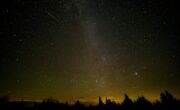
On warm summer nights, when the sunset fades and the crickets and night birds begin their chorus, it is the perfect time to look up at the stars. Stargazing has been a well-loved pastime for millennia, and with good reason. The stars and planets in their neat arrangement, along with the moon in its phases, hold a strange beauty that fills us with a sense of the scale of our lives, the hugeness of our galaxy, and everything beyond it.
Where to go
The ideal places to stargaze are high places such as hill or mountain overlooks or open fields, where no trees or hills or buildings block your view. It’s best to find a spot where there is not too much light pollution, if such a spot is available to you. But sometimes the best you can do is gaze through tree-branches and around structures and things that emit an artificial glow, and that’s okay too. Stargazing under less-than-ideal conditions is better than no stargazing at all! Bring a blanket or something comfortable that allows you to lean back without craning your neck.
When to go
Stars appear slowly, so prime stargazing time begins at least an hour after the sun has set. This can be pretty late during long summer days while the weather is warm, though, so going out sooner is also a viable option. You can observe which stars are the brightest, and which ones appear first. If you are interested in seeing the moon, consult a moon calendar to find out when it is full: due to its orbit, it appears in the sky at various times of day throughout its cycle, and its presence only overlaps perfectly with nighttime when it is full. Gibbous (more than half-full) moons are visible during larger portions of the night, and crescent moons for smaller timeframes.
What to look for
The easiest constellations for me to spot are Orion, with his signature three-star belt, and the Big Dipper, the ladle with its distinctive four-cornered “bowl.” Another easily recognizable constellation is the Pleiades, seven small stars that appear to be huddled in close to one another. Finding a constellation map such as a rotating hand-held constellation spotter or even an app is a great help for identifying them. Stargazing becomes more fun once you have learned to spot a few familiar figures. It is especially interesting to look up the stories behind the constellations’ namesakes; often, they are related to ancient Greek myths.
It will take a few excursions before you are able to memorize and consistently spot the constellations you found on the first evening you go stargazing. But it’s absolutely worth the patience, and the likely mosquito bites. You will be looking out upon the same stars that people have wondered about for generations and generations, so far back that we can’t comprehend it. Learning the names and the stories of stars and constellations adds in a beautiful way to the sense of humbleness that the night sky naturally instills; it connects us to all those before us who stood on a similar hill, or in a similar rustling field, and pointed up and spoke those same names: Sirius, Cassiopeia, Rigel, Taurus, Orion…
Enjoy your stargazing adventures!










